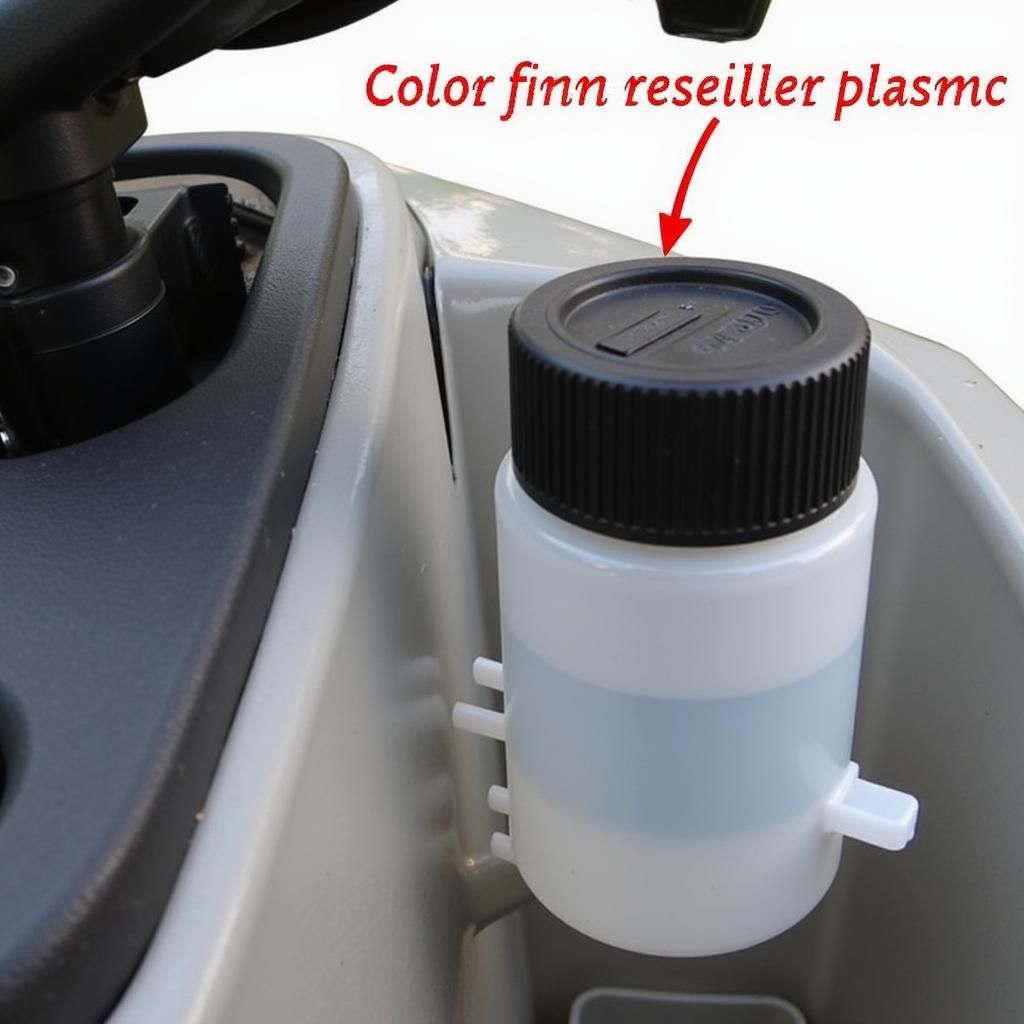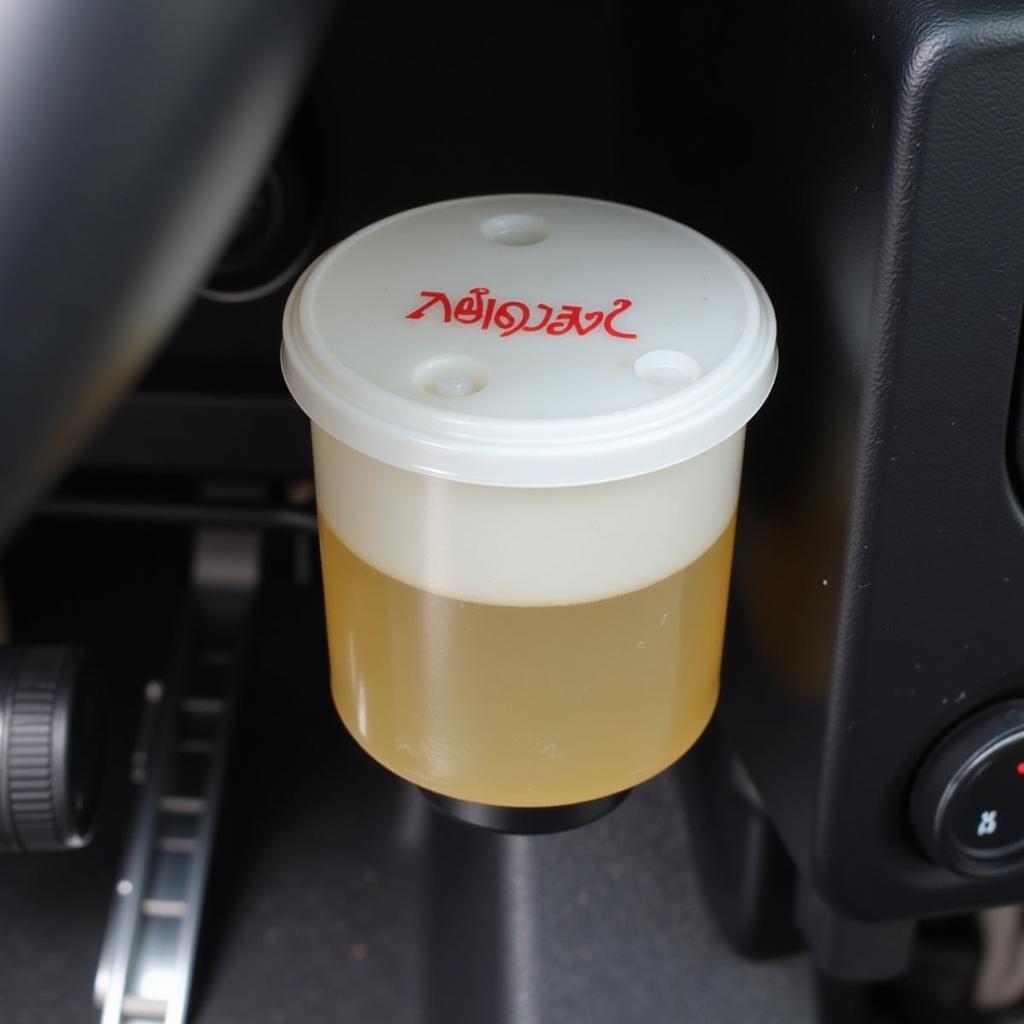The brake warning light on your 2008 Can-Am Outlander is a crucial safety feature that shouldn’t be ignored. When illuminated, it signals a potential problem with your ATV’s braking system that requires immediate attention. This comprehensive guide will walk you through the common causes of a lit brake warning light on a 2008 Can-Am Outlander and provide you with practical solutions to address them.
A common reason for the brake warning light to illuminate is low brake fluid. The brake fluid reservoir is located under the seat on the right side of your Outlander. Check the fluid level and top it off if necessary using DOT 4 brake fluid.
 Can-Am Outlander Low Brake Fluid Reservoir
Can-Am Outlander Low Brake Fluid Reservoir
However, if you find yourself adding brake fluid frequently, it could point to a leak in the system. Thoroughly inspect all brake lines, hoses, and connections for any signs of leakage, paying close attention to areas around the calipers and the master cylinder.
Another possible culprit is a faulty brake light switch. This switch is typically located near the brake lever and activates the brake light when the lever is engaged. If the switch malfunctions, it can disrupt the brake light circuit and trigger the warning light.
Testing the Brake Light Switch
To test the brake light switch, you’ll need a multimeter. Here’s a step-by-step guide:
- Locate the brake light switch: This is usually found near the brake lever on the handlebar.
- Disconnect the switch: Carefully disconnect the electrical connector from the switch.
- Set the multimeter: Set your multimeter to measure continuity or resistance (Ohms).
- Connect the multimeter probes: Touch one probe to each terminal of the switch.
- Engage and disengage the brake lever: While observing the multimeter reading, engage and disengage the brake lever several times.
- Interpret the results: A functioning switch will show a change in resistance or a continuity beep when the lever is pressed and released. If there’s no change, the switch is likely faulty and needs replacement.
Worn Brake Pads: A Silent Trigger
Worn brake pads are another common cause of an illuminated brake warning light. Most Outlander models are equipped with a wear sensor that triggers the light when the pads thin out beyond a safe limit.
“Regularly inspecting your brake pads is crucial for both safety and performance,” says veteran ATV mechanic, Mark Stevenson. “Don’t wait for the warning light to tell you it’s time for new pads. Catching wear early can save you from costly repairs down the road.”
To inspect the brake pads, remove the caliper and check the pad thickness. If the friction material is worn down to the wear indicator, or close to it, it’s time for a replacement.
Addressing Electrical Issues
Sometimes, the culprit behind a lit brake warning light might not be a mechanical fault but an electrical gremlin. A short circuit, loose wiring, or a blown fuse in the brake light circuit can all trigger the warning light.
Start by visually inspecting the wiring harness for any signs of damage, fraying, or loose connections. Pay attention to the area around the brake light switch, the brake fluid reservoir, and the wiring running to the rear brake light assembly.
If visual inspection doesn’t reveal any obvious issues, consult the wiring diagram in your owner’s manual and use a multimeter to test for continuity and voltage drop in the circuit.
When to Seek Professional Help
While this guide provides a starting point for troubleshooting your Can-Am Outlander’s brake warning light, remember that brakes are a critical safety system. If you are uncomfortable performing any of these checks or are unable to pinpoint the problem, it’s best to consult a qualified ATV mechanic or your Can-Am dealer. They have the expertise and equipment to diagnose and repair your ATV’s braking system safely and effectively.
Conclusion
A glowing brake warning light on your 2008 Can-Am Outlander is a signal that shouldn’t be ignored. From low brake fluid and faulty switches to worn pads and electrical issues, several factors could be at play. By understanding the potential causes and employing the troubleshooting tips outlined in this guide, you can keep your Outlander’s braking system in top shape, ensuring your safety and enjoyment on the trails.



